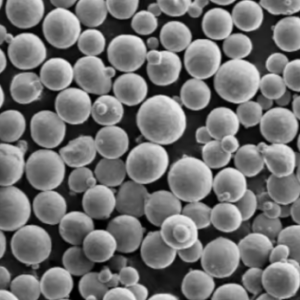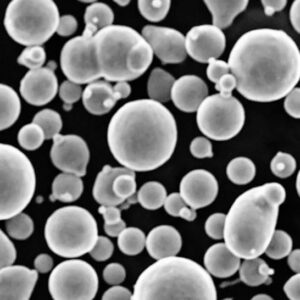電子ビーム積層造形 (EBAM) は金属加工の世界に革命を起こしている。電子ビームを使って金属粉末やワイヤーを融合させ、層ごとに金属部品を作るプロセスを想像してみてほしい。未来的に聞こえるだろう?しかし、それはもうSFの世界の話ではない。今まさに実現しつつあり、製造業に対する考え方を変えようとしているのだ。
電子ビーム積層造形(EBAM)の概要
EBAMは、高エネルギーの電子ビームを使用して金属粉末やワイヤーを溶融し、層ごとに融合させて複雑な金属部品を作成する高度な製造技術です。このプロセスには、複雑な形状の部品を作る能力、材料の無駄の削減、従来の製造方法と比べた製造時間の短縮など、数多くの利点がある。しかし、それは表面上のことにすぎない。
EBAMの主な詳細
- テクニック:電子ビームを利用して金属粉末やワイヤーを溶融・融合させる。
- 材料:主に各種金属粉やワイヤーに使用。
- アプリケーション:航空宇宙、自動車、医療用インプラントなど。
- メリット:高精度、無駄の削減、生産時間の短縮。

EBAMで使用される金属粉末の種類
エバムにはさまざまな種類の金属粉が使用されており、それぞれがユニークな特性と用途を持っている。ここでは具体的な10種類のモデルを紹介する:
| 金属粉 | 構成 | プロパティ | アプリケーション |
|---|---|---|---|
| Ti-6Al-4V | 6%のAlと4%のVを含むチタン合金 | 高強度、耐食性 | 航空宇宙、医療用インプラント |
| インコネル718 | ニッケル・クロム合金 | 高温耐性 | タービンブレード、航空宇宙部品 |
| ステンレススチール316L | 16-18%のCrと10-14%のNiを含む鉄合金 | 耐食性、耐久性 | 医療機器、食品加工機器 |
| AlSi10Mg | 10%のSiと0.3%のMgを含むアルミニウム合金 | 軽量、良好な熱伝導性 | 自動車部品、熱交換器 |
| 銅(Cu) | 純銅 | 優れた導電性 | 電気部品、ヒートシンク |
| ハステロイX | ニッケル基超合金 | 高温での耐酸化性 | ガスタービン、化学処理 |
| マルエージング鋼 (18Ni300) | 18%のNiと8-12%のCoを含む鉄-ニッケル合金 | 高強度、高硬度 | 工具、航空宇宙部品 |
| CoCrMo | コバルト・クロム・モリブデン合金 | 耐摩耗性、生体適合性 | 医療用インプラント、歯科用途 |
| Ti-6Al-2Sn-4Zr-6Mo | 6%のAl、2%のSn、4%のZr、6%のMoを含むチタン合金 | 高強度、耐疲労性 | 航空宇宙部品、高応力部品 |
| アルミニウム6061 | MgとSiを含むアルミニウム合金 | 軽量、多用途 | 構造部品、海洋用途 |
EBAM金属粉末の組成
EBAMで使用される金属粉末の組成を理解することは非常に重要である。これらの粉末は、製造プロセスの特定の要件を満たすように細心の注意を払って設計されています。
| 金属粉 | 主要な要素 | マイナー要素 |
|---|---|---|
| Ti-6Al-4V | チタン、アルミニウム、バナジウム | 酸素、窒素、炭素 |
| インコネル718 | ニッケル、クロム、鉄 | モリブデン、ニオブ、アルミニウム、チタン |
| ステンレススチール316L | 鉄、クロム、ニッケル | モリブデン、マンガン、シリコン |
| AlSi10Mg | アルミニウム、シリコン、マグネシウム | 鉄、銅、マンガン |
| 銅(Cu) | 銅 | 酸素、リン |
| ハステロイX | ニッケル、クロム、鉄 | モリブデン、コバルト、タングステン |
| マルエージング鋼 (18Ni300) | 鉄、ニッケル、コバルト | モリブデン、チタン、アルミニウム |
| CoCrMo | コバルト、クロム、モリブデン | ニッケル、鉄、炭素 |
| Ti-6Al-2Sn-4Zr-6Mo | チタン、アルミニウム、スズ、ジルコニウム、モリブデン | 酸素、鉄、ケイ素 |
| アルミニウム6061 | アルミニウム、マグネシウム、シリコン | 鉄、銅、亜鉛 |
EBAM金属粉末の特徴
EBAMで使用される金属粉末の特性は、その組成と同様に重要である。これらの特性は、製造工程や最終製品での材料の挙動を決定します。
| 特徴 | 説明 |
|---|---|
| 粒子径 | 通常15ミクロンから150ミクロン |
| 流動性 | 安定した粉体分布に不可欠 |
| 純度 | 材料の完全性を保証する高純度レベル |
| 密度 | 溶融・凝固プロセスに影響を与える |
| 耐酸化性 | 材料特性の維持に重要 |
応用例 電子ビーム積層造形 (EBAM)
EBAMは、航空宇宙部品から医療用インプラントまで、幅広い用途で使用されている。複雑な形状を作成し、高性能材料を使用する能力により、精度と性能が重要な産業に最適です。
| 産業 | アプリケーション |
|---|---|
| 航空宇宙 | タービンブレード、構造部品、エンジン部品 |
| 自動車 | 軽量部品、プロトタイプ、カスタム部品 |
| メディカル | インプラント、補綴物、手術器具 |
| エネルギー | タービン部品、熱交換器、燃料電池 |
| 工具 | カスタム金型、金型、治具 |
| ディフェンス | 防具、武器部品、特殊装備 |
| エレクトロニクス | ヒートシンク、コネクター、ケーシング |
EBAMの仕様、サイズ、グレード、規格
EBAMを使用する場合、最終製品の品質と性能を保証するために、特定の基準と仕様を遵守することが不可欠である。
| 金属粉 | サイズ | グレード | 規格 |
|---|---|---|---|
| Ti-6Al-4V | 15~45μm、45~90μm | グレード5 | アストマ F2924、アムス 4998 |
| インコネル718 | 15~45μm、45~106μm | 午前5662、午前5663 | ASTM B637 |
| ステンレススチール316L | 15~45μm、45~90μm | 316L | アストレムA276、アストレムF138 |
| AlSi10Mg | 15~45μm、45~106μm | – | ASTM B928、EN 1706 |
| 銅(Cu) | 15~45μm、45~106μm | C11000 | ASTM B170 |
| ハステロイX | 15~45μm、45~90μm | AMS 5754 | ASTM B619 |
| マルエージング鋼 (18Ni300) | 15~45μm、45~90μm | – | ASTM A538 |
| CoCrMo | 15~45μm、45~90μm | ASTM F75 | ISO 5832-4 |
| Ti-6Al-2Sn-4Zr-6Mo | 15~45μm、45~106μm | – | AMS 4919 |
| アルミニウム6061 | 15~45μm、45~90μm | 6061-T6 | アストレムB209、アストレムB221 |
EBAM金属粉末のサプライヤーと価格詳細
信頼できるサプライヤーを見つけ、価格設定を理解することは、EBAMを製造工程で活用しようとする人々にとって極めて重要である。
| サプライヤー | 金属粉 | 価格帯(kgあたり) |
|---|---|---|
| EOS GmbH | Ti-6Al-4V、インコネル718、ステンレス鋼316L | $300 – $500 |
| カーペンター・テクノロジー | AlSi10Mg、銅、ハステロイX | $250 – $600 |
| ヘガネスAB | マルエージング鋼、CoCrMo、Ti-6Al-2Sn-4Zr-6Mo | $200 – $700 |
| GKNアディティブ | アルミニウム6061、インコネル718、ステンレス鋼316L | $300 – $550 |
| AP&C(アルカム) | Ti-6Al-4V, Inconel718, AlSi10Mg 718, AlSi10Mg | $350 – $650 |
| LPWテクノロジー | 銅、ハステロイX、マルエージング鋼 | $250 – $600 |
| サンドビック | Ti-6Al-2Sn-4Zr-6Mo、CoCrMo、ステンレス鋼316L | $200 – $700 |
| プラクセア | インコネル718、アルミニウム6061、Ti-6Al-4V | $300 – $600 |
| 金属分析 | Ti-6Al-4V、ハステロイX、AlSi10Mg | $250 – $650 |
| ATIメタルズ | ステンレス316L、銅、インコネル718 | $300 – $550 |
EBAMの長所と短所を比較する
EBAMを検討する際には、他の製造方法と比較してその利点と限界を天秤にかけることが重要である。
| アスペクト | メリット | 制限事項 |
|---|---|---|
| 精密 | 高精度で複雑な形状を作成可能 | 綿密な校正と管理が必要 |
| 材料効率 | 減法法に比べて廃棄物が少ない | 粉体の取り扱いとリサイクルは難しい |
| スピード | 特定部品の生産時間の短縮 | 初期設定と校正に時間がかかることがある |
| 材料特性 | 優れた機械的特性、高強度 | 電子ビームで加工可能な材料に限る |
| コスト | 小ロットおよびカスタム部品のコスト効率に優れる | 設備や資材への高額な初期投資 |
| 柔軟性 | カスタムパーツやワンオフパーツを簡単に作成できる | 従来の方法に比べ、大量生産には向いていない |
| 後処理 | 多くの場合、必要な後処理は最小限 | 用途により、追加仕上げが必要な部品もあります。 |

よくあるご質問
この革新的な技術について理解を深めていただくために、EBAMに関するよくある質問をご紹介します。
| 質問 | 回答 |
|---|---|
| EBAMとは? | EBAMとはElectron Beam Additive Manufacturing(電子ビーム積層造形)の略で、電子ビームを使って金属粉末やワイヤーを溶融・融合させ、パーツを1層ずつ作るプロセスである。 |
| EBAMで使用できる素材は? | チタン合金、ニッケル合金、ステンレス鋼、アルミニウム合金など、幅広い金属粉末とワイヤーを提供。 |
| EBAMの利点は何ですか? | 高精度、材料の無駄の削減、生産時間の短縮、複雑な形状の作成能力。 |
| EBAMの限界とは? | 初期投資が高く、綿密なキャリブレーションが必要で、電子ビームで加工できる材料に限られる。 |
| どのような業界がEBAMを使用していますか? | 航空宇宙、自動車、医療、エネルギー、工具、防衛、エレクトロニクス。 |
| EBAMは他の3Dプリント方法と比べてどうですか? | EBAMは優れた機械的特性を持ち、高性能のアプリケーションに適しているが、コストが高く、セットアップが複雑になる可能性がある。 |
| EBAMに使用される一般的な金属粉末にはどのようなものがありますか? | Ti-6Al-4V、インコネル718、ステンレス鋼316L、AlSi10Mg、銅、ハステロイX、マルエージング鋼、CoCrMo、Ti-6Al-2Sn-4Zr-6Mo、アルミニウム6061。 |
| EBAM部品に後処理は必要ですか? | EBAM部品は多くの場合、最小限の後処理で済むが、用途によっては追加の仕上げが必要になることもある。 |
| EBAMの電子ビームはどのように機能するのですか? | 電子ビームは熱を発生させ、金属粉末やワイヤーを一層ずつ溶かして融合させ、部品を作る。 |
| EBAMの将来は? | EBAMの将来は有望であり、材料の進歩、プロセスの最適化、さまざまな産業における用途の拡大が進んでいる。 |
結論
電子ビーム積層造形 (EBAM) は、製造業に対する考え方を一変させる画期的な技術である。高エネルギーの電子ビームを利用して金属粉末やワイヤーを溶融・融合させることで、EBAMは複雑で高性能な部品を、無駄を最小限に抑え、生産時間を短縮して製造することができます。航空宇宙、自動車、医療、その他精密さと性能を要求される産業であろうと、EBAMは魅力的なソリューションを提供します。さあ、EBAMの可能性を探求し、あなたの製造工程にどのような革命を起こせるか見てみませんか?














